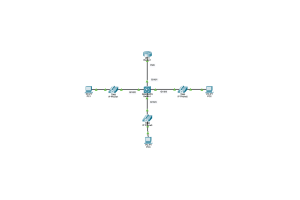
This is Packet Tracer Lab that has 2 core switches (Core 1 and 2), 3 access switches (Access 1, 2, and, 3), a server (Server 1), Edge Router (Router 0), and the Internet (Server 8.8.8.8 and cisco.com).
For this Lab, various technology is used for the Campus Network to work well like CDP, LLDP, Etherchannel, LACP, HSRP, VLANs, and EIGRP. We are going to discuss these technologies and see where they are applied in the Campus Network.
Link Layer Discovery Protocol is a layer 2 neighbor discovery protocol that allows devices to advertise device information to their directly connected peers/neighbors. It is best practice to enable LLDP globally to standardize network topology across all devices if you have a multi-vendor network.
It was introduced by IETF as a standard vendor-neutral configuration exchange protocol.
Using LLDP, device information such as chassis identification, port ID, port description, system name and description, device capability (as router, switch, hub…), IP/MAC address, etc., are transmitted to the neighboring devices. This information is also stored in local Management Information Databases (MIBs) and can be queried with the Simple Network Management Protocol (SNMP). The LLDP-enabled devices have an LLDP agent installed, which sends out advertisements from all physical interfaces either periodically or as changes occur.
It is the same as CDP but it is not vendor-proprietary.
For this lab, LLDP was enabled which displays the devices connected to Core2.
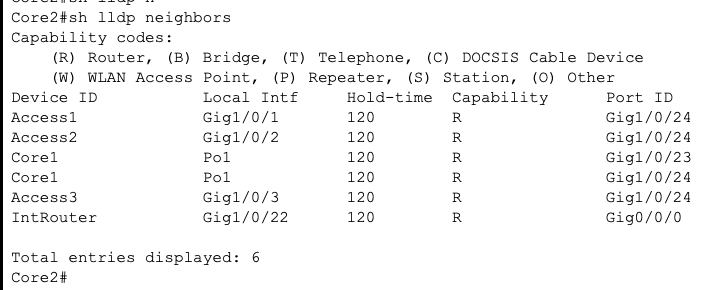
CDP is a Cisco proprietary protocol that is used for collecting directly connected neighbor device information like hardware, software, and device name details.
CDP is a protocol that runs over Layer 2 (the data link layer) on all Cisco routers, bridges, access servers, and switches. CDP allows network management applications to discover Cisco devices that are neighbors of already known devices, in particular, neighbors running lower-layer, transparent protocols. With CDP, network management applications can learn the device type and the SNMP agent address of neighboring devices. CDP enables applications to send SNMP queries to neighboring devices.
CDP runs on all LAN and WAN media that support Subnetwork Access Protocol (SNAP).
Each CDP-configured device sends periodic messages to a multicast address. Each device advertises at least one address at which it can receive SNMP messages. The advertisements also contain the
time-to-live, or hold time information, which indicates the length of time a receiving device should hold CDP information before discarding it.
For this lab, CDP was enabled which displays the devices connected to Core2.

An EtherChannel bundles individual Ethernet links into a single logical link that provides the aggregate
bandwidth of up to eight physical links.
You can configure EtherChannels manually or you can use the Port Aggregation Control Protocol
(PAgP) or the Link Aggregation Control Protocol (LACP) to form EtherChannels. The EtherChannel
protocols allow ports with similar characteristics to form an EtherChannel through dynamic negotiation
with connected network devices. PAgP is a Cisco-proprietary protocol and LACP is defined in IEEE
802.3ad.
PAgP supports the automatic creation of EtherChannels by exchanging PAgP packets between LAN ports. PAgP packets are exchanged only between ports in auto and desirable modes.
LACP supports the automatic creation of EtherChannels by exchanging LACP packets between LAN ports. LACP packets are exchanged only between ports in passive and active modes.
For the Lab LACP is used to aggregate the links between Core1 and Core2 into one. Both switches are set to active, for them to actively form a link with each other.
Aggregated Link
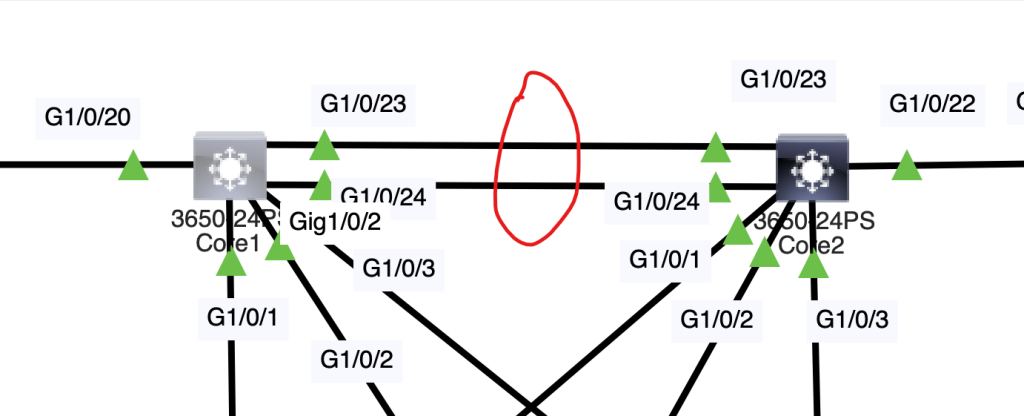
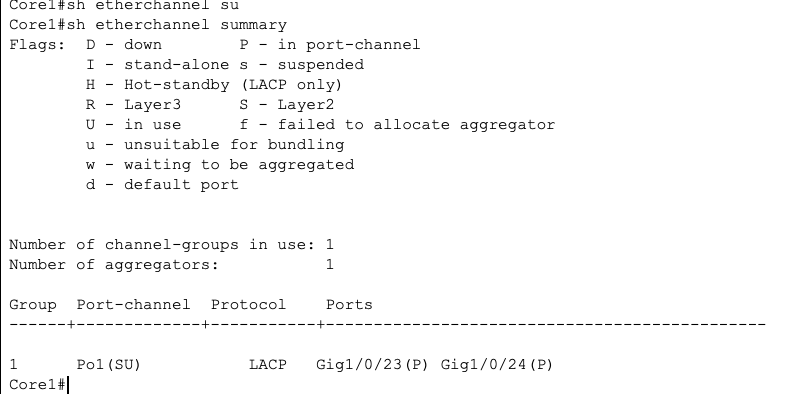
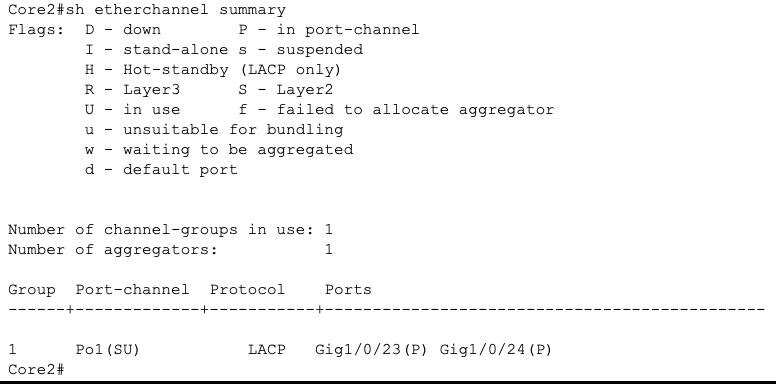
It commonly used First Hop Redundancy Protocols. There are also other protocols like (VRRP) Virtual Router Redundancy Protocol and (GLBP) Gateway Load Balancing Protocol.
For the lab HSRP is configured on Core1 and Core2, HSRP is a CISCO proprietary redundancy protocol that allows failover of the next-hop IP device. It operates with an Active-Standby Mobel where only one device supports end-user traffic at any time, and the other device is on standby waiting to take over if the other device fails.
A Virtual IP Address is configured for VLAN 10, 20, 30, and 100
Virtual IP Address
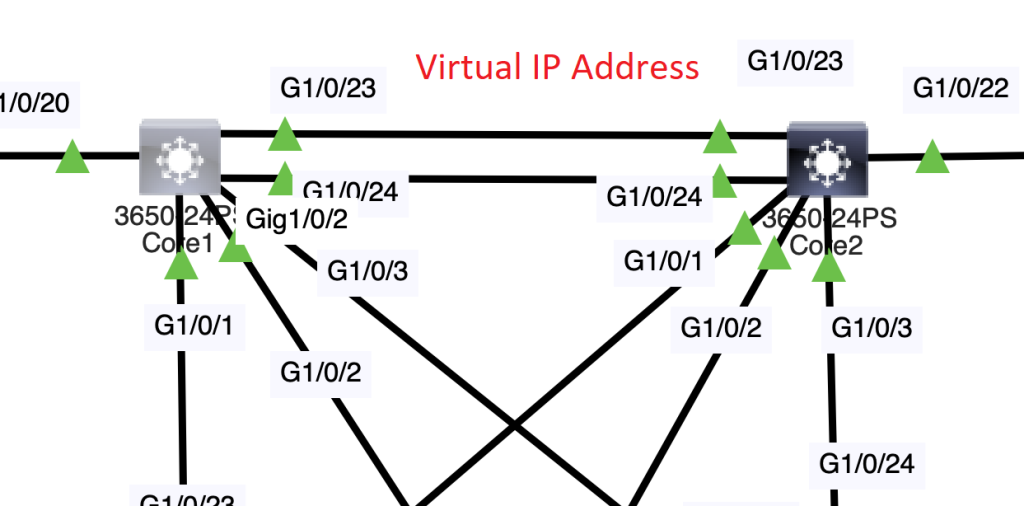
It is a dynamic routing protocol that is used to find the best path between any two-layer 3 devices to deliver the packet. EIGRP works on the network layer Protocol of the OSI model and uses protocol number 88. It uses metrics to find out the best path between two layer 3 devices (router or layer 3 switches) operating EIGRP.
EIGRP is configured on Core1, Core2, and IntRouter. For the devices to have the IP addresses (VLAN 10, 20, 30, and 100) on their Routing Table.
It is a dynamic routing protocol that is used to find the best path between any two-layer 3 devices to deliver the packet. EIGRP works on the network layer Protocol of the OSI model and uses protocol number 88. It uses metrics to find out the best path between two layer 3 devices (router or layer 3 switches) operating EIGRP.
EIGRP is configured on Core1, Core2, and IntRouter. For the devices to have the IP addresses (VLAN 10, 20, 30, and 100) on their Routing Table.
It’s a way to map multiple private addresses inside a local network to a public IP address before transferring the information onto the internet.
For the Lab NAT is implemented at IntRouter to allow PCs and the Server to ping 8.8.8.8 and cisco.com, these two devices represent the internet.
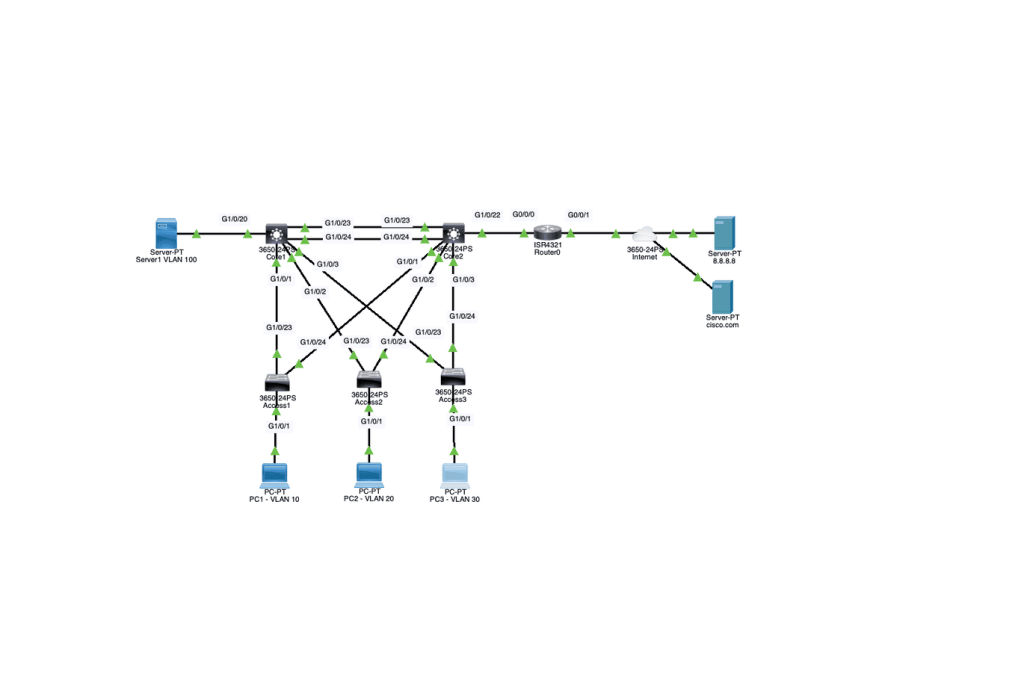
This is a Summary of my documentation of the Lab
The course can be found at Udemy by David Bombal